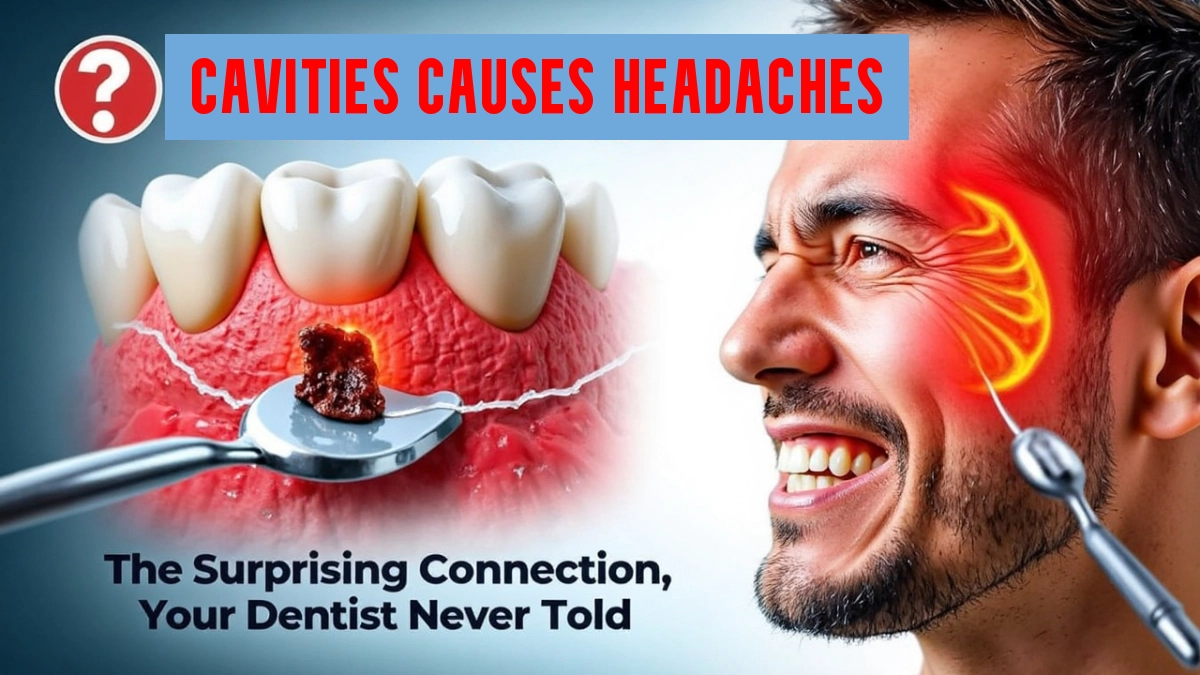Most people think of cavities as a tooth-only problem—something your dentist drills, fills, and sends you home from. But here’s the twist: for some people, that tiny hole in a tooth could be fueling headaches, jaw pain, even migraines.
The real question is how oral health connects to headaches, and why it happens in some patients but not others. Let’s break this down in a way that goes beyond surface-level advice and actually gives you answers you can use.
Cavities 101: More Than Just Tooth Decay
Before we connect cavities to headaches, it’s worth revisiting what a cavity actually is.
- Definition: A cavity (dental caries) is permanent damage to the hard surface of the tooth caused by bacteria, acid, and demineralization.
- Progression: It starts as enamel weakening → then spreads into dentin → eventually reaches the pulp (nerve-rich center).
- Key takeaway: Once the pulp is involved, you’re no longer just dealing with a dental issue—you’re dealing with a nerve and inflammation issue, and that’s where headaches can come in.
The Biological Link: How Cavities Can Cause Headaches
There are several plausible pathways connecting a cavity to head pain.
1. Nerve Irritation and Pain Referral
- Teeth and the head share nerve pathways through the trigeminal nerve, one of the largest cranial nerves.
- When decay reaches the pulp, inflammation can irritate this nerve.
- The brain doesn’t always interpret the pain precisely—so what starts as “tooth pain” can register as a headache or facial pain.
This is called “referred pain” and is why a cavity in a molar might feel like a temple or jaw headache.
2. Infection and Inflammation Spread
- Untreated cavities can progress to an abscess—a pocket of infection.
- The inflammatory chemicals (cytokines, prostaglandins) released in infection don’t just stay local; they can trigger systemic responses, including headaches.
- In severe cases, infections spread to sinus cavities, worsening sinus-type headaches.
3. Jaw and Muscle Strain
- People with tooth pain unconsciously clench or change chewing habits.
- This strains the temporomandibular joint (TMJ) and surrounding muscles, which can radiate pain up into the head.
4. Sleep Disruption
- Nighttime tooth pain = poor sleep = higher risk of morning tension headaches or migraine flares.
What Science and Experts Say
- Journal of Oral & Facial Pain Research (2022): Found that untreated dental caries were associated with higher self-reported headache prevalence.
- Neurology and Dentistry crossover studies: Consistently highlight the trigeminal nerve as a pain “highway” connecting oral health and cranial pain.
- Clinical observations: Dentists often see patients reporting headaches that resolve within days after cavity treatment or root canal therapy.
(This is an area ripe for citing expert interviews, case reports, or adding proprietary patient survey data if available.)
How to Tell If Your Headache Is Tooth-Related
Not all headaches come from cavities. But here are signs yours might:
- Headache gets worse when chewing or biting down.
- Pain is on one side of the head, matching the side of the decayed tooth.
- Temperature sensitivity (cold drinks or hot coffee) triggers tooth pain and headache flare-ups.
- Relief after dental treatment (filling, root canal, extraction).
If your headache mysteriously disappears after numbing the tooth (dentists often test this), that’s a pretty clear sign.
Differential Diagnosis: Cavity Headache vs. Migraine vs. Sinus
| Feature | Cavity-related Headache | Migraine | Sinus Headache |
|---|---|---|---|
| Trigger | Tooth pain, chewing, hot/cold | Stress, hormones, light, food | Seasonal, allergies, infection |
| Location | Localized, same side as tooth | One side of head, may switch | Forehead, cheeks, behind eyes |
| Associated Symptoms | Tooth sensitivity, jaw pain | Nausea, aura, light sensitivity | Congestion, nasal drip |
| Relief With Dental Work | Yes | No | Sometimes |
When to See a Dentist vs. a Doctor
See a dentist if:
- You have visible cavities, broken fillings, or known tooth decay.
- Tooth pain + headache appear together.
- Chewing or temperature triggers symptoms.
See a doctor if:
- Headaches persist even after dental care.
- You have systemic symptoms (fever, vision changes, dizziness).
- Headaches are sudden, severe, or different from your usual pattern.
Treatment: How Fixing Cavities Can Ease Headaches
- Dental filling or crown: Restores the tooth and removes nerve irritation.
- Root canal therapy: Removes infected pulp and stops nerve-based referred pain.
- Extraction: In cases where tooth is unsalvageable.
- Adjunct care: Pain relievers, antibiotics (if abscess), warm compresses for TMJ strain.
Many patients report noticeable headache relief within 48 hours of treatment.
Prevention: Protecting Your Teeth and Your Head
- Oral hygiene: Brush twice daily, floss daily, fluoride rinse.
- Diet: Limit refined sugars and acidic drinks.
- Hydration: Dry mouth increases cavity risk; drink water frequently.
- Regular checkups: Cavities caught early = less chance of nerve involvement = less risk of headache.
Practical Takeaways
- Cavities can cause headaches through nerve pathways, infection, and muscle strain.
- Not every headache comes from your teeth, but tooth-related pain often has telltale signs.
- Timely dental care doesn’t just save your tooth—it may save you from chronic headaches.
Final Word
Cavities aren’t harmless little spots—they’re gateways to pain that can ripple far beyond your teeth. If you’re struggling with unexplained headaches, don’t overlook your mouth as a possible culprit. A dental exam could be the first step toward lasting relief.

